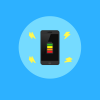Look Ma, No Hands: A Look into Wireless Charging
With Samsung, Google, and Microsoft already utilizing inductive, or wireless charging, rumor has it that Apple’s next iteration of the iPhone will include their own take on the charging method. Setting your phone down on a tiny dock and not worrying about having to plug it in to charge it might seem like magic to some, but it’s a very real possibility in 2017.
Qi (pronounced like “chee”), the accepted standard for inductive charging, was developed by Wireless Power Consortium for charging at a distance of up to 4 cm. As it becomes more popular, it is expected that public areas and businesses will begin installing docking stations for wireless charging. But how does it actually work?
How Induction Charging Works
Inductive charging uses an electromagnetic field to transfer energy between two objects through the aptly named process of electromagnetic induction. We’re probably all familiar with induction heating where an electrically conducting object is heated by eddy currents. This process is used in induction stoves and furnaces.
Induction charging generates a magnetic field using coils and an antenna that can be found in both the device and the charging station. Electromagnetic shielding is employed to direct the magnetic field back into the antenna. The surface must also be “tuned” to ensure that the field reaches above the surface of the dock or furniture that it is placed inside of.
In tests, other metal objects were placed on the charging pad along with devices as an experiment. In a normal induction heating apparatus, the metal objects would significantly heat up. However, in this experiment, the devices continued charging as usual and did not experience any temperature changes.
As an added bonus, by going with wireless, electromagnetic charging and eliminating power cords, you also do away the inconvenience of frayed cords and the danger of tripping. However, with such a close proximity to the dock needed, it limits any mobility. While a phone is charging, you aren’t going anywhere! Charge times for induction charging are also quite a bit slower than those of charging cords. In the future, this will likely improve, but until then, you’ll have to wait a little bit longer for your devices to charge.
Wireless charging is a game-changer; that’s for certain. It could soon apply to larger devices and potentially expand the field of the charge. One day, your whole home could be powered wirelessly!
Would you enjoy full wireless charging on every electronic device? To stay on top of the latest magnet-related findings, check out our News & How-Tos blog.

